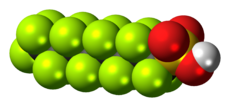PFOS
 |
|
 |
|
| Names | |
|---|---|
|
Systematic IUPAC name
1,1,2,2,3,3,4,4,5,5,6,6,7,7,8,8,8-Heptadecafluoro-1-octanesulfonic acid
|
|
| Other names
PFOS
|
|
| Identifiers | |
|
3D model (Jmol)
|
|
| ChEBI | |
| ChemSpider | |
| ECHA InfoCard | 100.015.618 |
| EC Number | 217-179-8 |
| KEGG | |
|
PubChem CID
|
|
|
|
|
|
| Properties | |
| C8HF17O3S | |
| Molar mass | 500.13 g/mol |
| Boiling point | 133 °C (271 °F; 406 K) at 6 torr |
| Acidity (pKa) | <<0 |
| Hazards | |
|
EU classification (DSD)
|
Toxic (T) Dangerous for the environment (N) |
| R-phrases | R61, R20/22, R40, R48/25, R64, R51/53 |
| S-phrases | S53, S45, S61 |
| Related compounds | |
|
Related compounds
|
Perfluorooctanoic acid (PFOA), Perfluorobutanesulfonic acid (PFBS), Perfluorooctanesulfonamide (PFOSA), Perfluorononanoic acid (PFNA) |
|
Except where otherwise noted, data are given for materials in their standard state (at 25 °C [77 °F], 100 kPa).
|
|
|
|
|
| Infobox references | |
Perfluorooctanesulfonic acid (conjugate base perfluorooctanesulfonate) (PFOS) is an anthropogenic fluorosurfactant and global pollutant. PFOS was the key ingredient in Scotchgard, a fabric protector made by 3M, and numerous stain repellents. It was added to Annex B of the in May 2009. PFOS can be synthesized in industrial production or result from the degradation of precursors. PFOS levels that have been detected in wildlife are considered high enough to affect health parameters, and recently higher serum levels of PFOS were found to be associated with increased risk of chronic kidney disease in the general US population. "This association was independent of confounders such as age, sex, race/ethnicity, body mass index, diabetes, hypertension, and serum cholesterol level."
In 1949, 3M began producing PFOS-based compounds by electrochemical fluorination resulting in the synthetic precursor perfluorooctanesulfonyl fluoride. In 1968, organofluorine content was detected in the blood serum of consumers, and in 1976 it was suggested to be PFOA or a related compound such as PFOS. In 1997, 3M detected PFOS in blood from global blood banks. In 1999, the U.S. Environmental Protection Agency began investigating perfluorinated compounds after receiving data on the global distribution and toxicity of PFOS, the key ingredient in Scotchgard. For these reasons, and USEPA pressure, the primary American producer of PFOS, 3M, announced, in May 2000, the phaseout of the production of PFOS, PFOA, and PFOS-related products. PFOS and PFOS-related chemicals are currently produced in China.
...
Wikipedia
